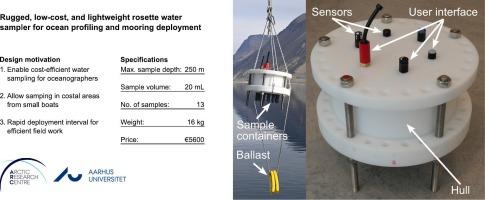坚固耐用,成本低,重量轻,适用于海洋剖面和系泊部署
IF 2.1
Q3 ENGINEERING, ELECTRICAL & ELECTRONIC
引用次数: 0
摘要
研究气候变化、海洋生态系统和水团分布的海洋学家在很大程度上依赖于不同深度和位置的海水测量。获得这些测量结果的一个关键工具是玫瑰花形水采样器,它在多个指定深度收集和分离海水,供以后分析。然而,大多数商业上可用的采样器是为大样本量(>;500毫升)设计的,需要重型起重设备,通常只在大型研究船上发现。这带来了不必要的成本和操作挑战,特别是在不需要大量样本的沿海地区。为此,我们提出了一种小型、轻质、坚固耐用的玫瑰花形水采样器,专门用于更小的样本量,并且无需起重设备即可从小船上高效部署。该取样器重16公斤,可在单个剖面铸型中收集13个20毫升的样品,最大深度为250米。该仪器已在2021年至2023年的三次实地活动中在格陵兰东北部和格陵兰东部海岸成功进行了测试。进一步的开发可以进一步减轻重量,提高易用性,增强其广泛应用的实用性。本文章由计算机程序翻译,如有差异,请以英文原文为准。

Rugged, low-cost, and lightweight rosette water sampler for ocean profiling and mooring deployment
Oceanographers studying climate change, marine ecosystems, and water mass distribution rely heavily on seawater measurements from various depths and locations. A critical tool for obtaining these measurements is the rosette water sampler, which collects and isolates seawater at multiple specified depths for later analysis. However, most commercially available samplers are designed for large sample volumes (>500 mL), requiring heavy-duty lifting equipment typically found only on larger research vessels.
This creates unnecessary costs and operational challenges, especially in coastal areas, when large sample volumes are not needed. In response, we present a small, lightweight, and rugged rosette water sampler specifically developed for smaller sample volumes and efficient deployment from small boats without the need for lifting equipment. Weighing 16 kg, the sampler can collect 13 samples of 20 mL each in a single profiling cast, with a maximum depth of 250 m. The instrument has been successfully tested in Northeast Greenland and along the East Greenland coast during three field campaigns between 2021 and 2023. Further development could lead to additional weight reductions and improved ease of use, enhancing its practicality for broader applications.
求助全文
通过发布文献求助,成功后即可免费获取论文全文。
去求助
来源期刊

HardwareX
Engineering-Industrial and Manufacturing Engineering
CiteScore
4.10
自引率
18.20%
发文量
124
审稿时长
24 weeks
期刊介绍:
HardwareX is an open access journal established to promote free and open source designing, building and customizing of scientific infrastructure (hardware). HardwareX aims to recognize researchers for the time and effort in developing scientific infrastructure while providing end-users with sufficient information to replicate and validate the advances presented. HardwareX is open to input from all scientific, technological and medical disciplines. Scientific infrastructure will be interpreted in the broadest sense. Including hardware modifications to existing infrastructure, sensors and tools that perform measurements and other functions outside of the traditional lab setting (such as wearables, air/water quality sensors, and low cost alternatives to existing tools), and the creation of wholly new tools for either standard or novel laboratory tasks. Authors are encouraged to submit hardware developments that address all aspects of science, not only the final measurement, for example, enhancements in sample preparation and handling, user safety, and quality control. The use of distributed digital manufacturing strategies (e.g. 3-D printing) is encouraged. All designs must be submitted under an open hardware license.
 求助内容:
求助内容: 应助结果提醒方式:
应助结果提醒方式:


